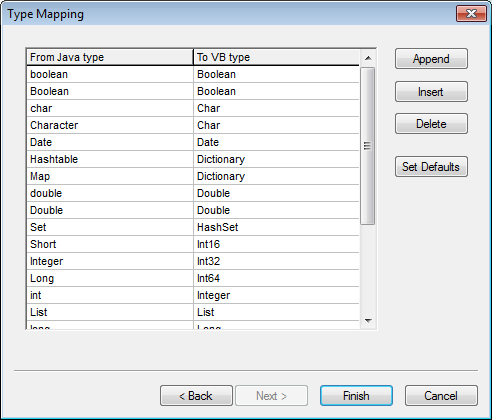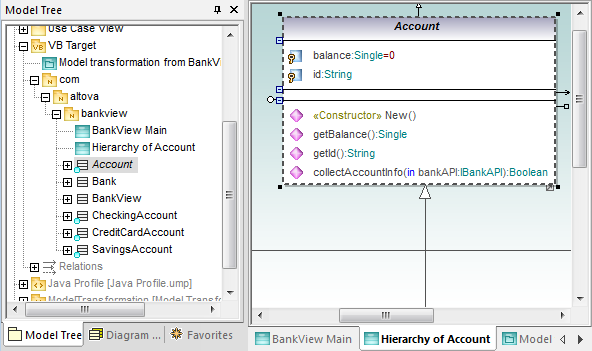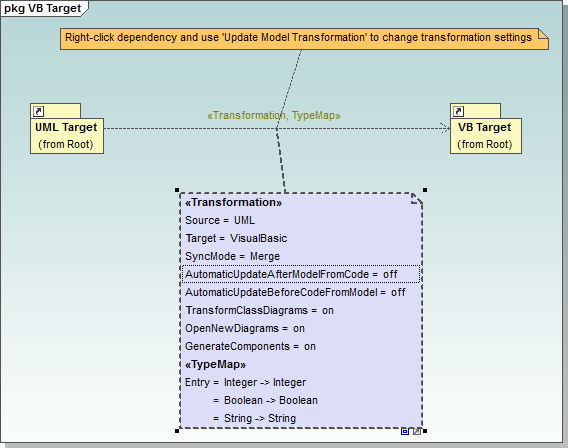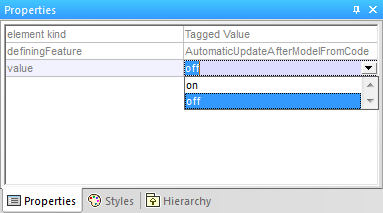Model Driven Architecture with Altova UModel
For Version 2012, UModel introduces Model Driven Architecture (MDA), with platform-independent models and a Model Transformation feature that transforms all code relevant modeling elements to and from UML, C#, Visual Basic, Java, databases, and XML Schema. Model Transformation A Model Driven Architecture approach to software engineering with platform independent models provides two primary advantages:
- During the design phase, developers do not need to be concerned with the details and variations between software languages
- An existing UModel project can be transformed from one source code language to another. For instance, a UML model for a C# application can become a Java or Visual Basic project
Users can even apply model transformation to projects that were reverse engineered from existing source code. For instance, an existing Java application can be reverse-engineered by UModel then transformed to generate Visual Basic classes, and many other possibilities are available.  Platform Independent Models Model Driven Architecture is a set of standards and methods for applying the UML (Unified Modeling Language) administered by the Object Management Group. In Model Driven Architecture, the UML model of a software project is a platform independent model (PIM) that can be fully described without concern for the details of any specific programming language. This development strategy allows software architects and other developers to focus exclusively on logic required by the subject domain, rather than characteristics of any programming language. Data Type Mapping During model transformation, UModel maps data types from the source to the target to accommodate differences between languages. The Type Mapping dialog lets you review or even edit type mapping pairs.
Platform Independent Models Model Driven Architecture is a set of standards and methods for applying the UML (Unified Modeling Language) administered by the Object Management Group. In Model Driven Architecture, the UML model of a software project is a platform independent model (PIM) that can be fully described without concern for the details of any specific programming language. This development strategy allows software architects and other developers to focus exclusively on logic required by the subject domain, rather than characteristics of any programming language. Data Type Mapping During model transformation, UModel maps data types from the source to the target to accommodate differences between languages. The Type Mapping dialog lets you review or even edit type mapping pairs.  UModel also automatically adds the target language profile to the transformed project. UML Class Diagrams As part of the model transformation, UModel creates new UML classes and class diagrams for the target, reflecting classes and class diagrams in the original project. The screen shot below shows the Hierarchy of Account diagram for Visual Basic after model transformation from Java. The new Account class in the new folder named VB Target in the model tree contains Visual Basic syntax for all properties and operations. For instance, the new balance property is defined as the Visual Basic Single data type, whereas in Java the data type was float. After transformation, the original Account class for Java is preserved in the model in its original location in the model tree. The original UML design for Java will now generate code in multiple source code languages – Java and Visual Basic.
UModel also automatically adds the target language profile to the transformed project. UML Class Diagrams As part of the model transformation, UModel creates new UML classes and class diagrams for the target, reflecting classes and class diagrams in the original project. The screen shot below shows the Hierarchy of Account diagram for Visual Basic after model transformation from Java. The new Account class in the new folder named VB Target in the model tree contains Visual Basic syntax for all properties and operations. For instance, the new balance property is defined as the Visual Basic Single data type, whereas in Java the data type was float. After transformation, the original Account class for Java is preserved in the model in its original location in the model tree. The original UML design for Java will now generate code in multiple source code languages – Java and Visual Basic.  Persistent Transformation Parameters The transformation paradigm extends to updating existing transformations and merging the updates into the specified target models. Transformation parameters are stored in a Model Transformation Profile in the model. The Transformation Profile can be set to run transformations automatically before forward engineering code generation, and/or after reverse engineering, to update elements for one target language based on changes to model elements for another.
Persistent Transformation Parameters The transformation paradigm extends to updating existing transformations and merging the updates into the specified target models. Transformation parameters are stored in a Model Transformation Profile in the model. The Transformation Profile can be set to run transformations automatically before forward engineering code generation, and/or after reverse engineering, to update elements for one target language based on changes to model elements for another.  These Transformation Profile settings can also be changed at any time.
These Transformation Profile settings can also be changed at any time.  This functionality lets UModel automate much of the maintenance of multiple source code languages as your cross-platform model evolves. If you’d like to try out Model Driven Architecture and model transformation with UModel 2012, you can download a free 30-day trial.
This functionality lets UModel automate much of the maintenance of multiple source code languages as your cross-platform model evolves. If you’d like to try out Model Driven Architecture and model transformation with UModel 2012, you can download a free 30-day trial.
